Istanbul is full of great restaurants. Local chefs who have made their name in the world have returned to open their own places and showcase their talents. Naturally, it’s food lovers that get to enjoy the fruits of their labor.
Some of Istanbul’s good restaurants have been around forever, attracting the same troupe of regulars, while others are newer. Thanks to their experience overseas, our chefs are changing culinary culture. Ultimately, the growing diversification and development of views on cuisine are benefiting the world of gastronomy.
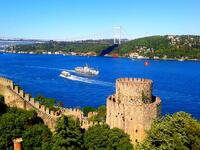 Istanbul is filled with restaurants – some elegant, some down on their heels, and a whole lot of them that are excellent. That’s why, to be honest, whittling everything down to just 15 was a difficult task. I travel a lot for business, and everywhere I go, I try the cuisine. But what I miss the most about Istanbul, especially after long trips, is grilled fish by the Bosphorus. Nothing compares to some Turkish tapas-style dishes called “meze,” followed by a good grilled fish while gazing at the captivating view of the Bosphorus and Istanbul. In reality, no meal is as easy as grilled fish! Buy some fresh fish, cook it in the oven or grill it, and voilà! Make sure the duration is right and stop cooking before it gets dry inside. You don’t need to work too hard. You don’t need special sauces or side dishes. Maybe a little good salt and virgin cold-pressed olive oil. And there’s no better gastronomical pleasure than eating fresh, grilled fish on a warm Istanbul evening by the sea. It’s an experience that even outstrips the joy one experiences at a top-rated restaurant. Of course, it’s not all about the fish, because there’s also the mezes in Istanbul. Italians and Spaniards have meze-like dishes, but you can’t compare them with the whole meze experience in Turkey: Digging into meze and fish by the Bosphorus is something completely different.
Istanbul is filled with restaurants – some elegant, some down on their heels, and a whole lot of them that are excellent. That’s why, to be honest, whittling everything down to just 15 was a difficult task. I travel a lot for business, and everywhere I go, I try the cuisine. But what I miss the most about Istanbul, especially after long trips, is grilled fish by the Bosphorus. Nothing compares to some Turkish tapas-style dishes called “meze,” followed by a good grilled fish while gazing at the captivating view of the Bosphorus and Istanbul. In reality, no meal is as easy as grilled fish! Buy some fresh fish, cook it in the oven or grill it, and voilà! Make sure the duration is right and stop cooking before it gets dry inside. You don’t need to work too hard. You don’t need special sauces or side dishes. Maybe a little good salt and virgin cold-pressed olive oil. And there’s no better gastronomical pleasure than eating fresh, grilled fish on a warm Istanbul evening by the sea. It’s an experience that even outstrips the joy one experiences at a top-rated restaurant. Of course, it’s not all about the fish, because there’s also the mezes in Istanbul. Italians and Spaniards have meze-like dishes, but you can’t compare them with the whole meze experience in Turkey: Digging into meze and fish by the Bosphorus is something completely different.
I also have the habit of eating dessert after a good fish. I know this ritual sounds like calorific suicide, but a good balance of salad, meze, and the best cornbread you’ll ever taste in your life will make you feel better. It’s best to eat fish in Istanbul between April and October. If you eat in the fall and winter, you’ll probably have to dine indoors – something that might knock the enjoyment factor down a peg or two. Above all, you don’t get to see the perfect combination of the Bosphorus and perhaps the full moon. And if you don’t believe me, just ask any guest who’s happened to experience such a night. On the other hand, have a couple of criteria regarding fish restaurants. For one, they need to be right by the sea – there can’t be any intervening roads whatsoever between the restaurant and the sea. It’s also important to have the option for indoor and outdoor dining.
Above all, however, my overriding expectation is that the fish will be cooked appropriately: It can’t be too dry or undercooked, as I mentioned before; it has to be just slightly moist in the middle.
ALAF  Located on the top floor of a building behind Kuruçeşme Park, Alaf is a restaurant that boasts a wonderful terrace. Opened just last year, Alaf is a place that is heavy on meat and giblets, offering fusion Turkish cuisine, including some dishes that stretch all the way back to Central Asia. Alaf’s menu, however, does change based on the season. In Alaçatı in İzmir, there was a restaurant I really liked, Alancha, that belonged to Kemal Demirasal, who doubled as the head chef. Demirasal grew up in his mother’s kitchen– an accomplished cook – which is why it’s not entirely surprising that he gave himself over to food even though he’s also a surf instructor and an economist. Alongside his right-hand man, Deniz Temel, Demirasal created wonderful dishes at Alancha for the three or four months of the year that the restaurant was open. Even if I’ve never been much of a fan of Alaçatı, I would occasionally make my way to the town just to enjoy Alancha’s fare. Today, seven years on from the fame Alancha enjoyed, there’s now a restaurant called YEK in its place. In any case, Temel eventually came to Istanbul to open Alaf, serving up some dishes whose origins lie in Alancha’s kitchen and some that are his own recent creations. While these two esteemed chefs from Alancha share some common ground, they’ve also proven their ability to develop their own styles in time. And however much I used to like Alancha, that’s how much I now appreciate what Alaf has to offer. Alaf is a place where you’re sure to enjoy yourself, what with a view of the Bosphorus and prices that aren’t high to boot. And if you happen to have a foreign company in town, it’s a perfect place to bring them.
Located on the top floor of a building behind Kuruçeşme Park, Alaf is a restaurant that boasts a wonderful terrace. Opened just last year, Alaf is a place that is heavy on meat and giblets, offering fusion Turkish cuisine, including some dishes that stretch all the way back to Central Asia. Alaf’s menu, however, does change based on the season. In Alaçatı in İzmir, there was a restaurant I really liked, Alancha, that belonged to Kemal Demirasal, who doubled as the head chef. Demirasal grew up in his mother’s kitchen– an accomplished cook – which is why it’s not entirely surprising that he gave himself over to food even though he’s also a surf instructor and an economist. Alongside his right-hand man, Deniz Temel, Demirasal created wonderful dishes at Alancha for the three or four months of the year that the restaurant was open. Even if I’ve never been much of a fan of Alaçatı, I would occasionally make my way to the town just to enjoy Alancha’s fare. Today, seven years on from the fame Alancha enjoyed, there’s now a restaurant called YEK in its place. In any case, Temel eventually came to Istanbul to open Alaf, serving up some dishes whose origins lie in Alancha’s kitchen and some that are his own recent creations. While these two esteemed chefs from Alancha share some common ground, they’ve also proven their ability to develop their own styles in time. And however much I used to like Alancha, that’s how much I now appreciate what Alaf has to offer. Alaf is a place where you’re sure to enjoy yourself, what with a view of the Bosphorus and prices that aren’t high to boot. And if you happen to have a foreign company in town, it’s a perfect place to bring them.
Alaf also possesses a wine list full of adroitly chosen Turkish wines. In terms of specific fare, its dishes made with whatever seafood is in season, humus, varieties of pide and unique kokoreç – a spicy Turkish delicacy made with lamb intestines – all jump out at you from the menu. Alaf’s baklava, too, is out of this world, although that won’t be a surprise to those that remember Alancha’s baklava. Putting it all together, Deniz Temel has done something wonderful at Alaf. With its open kitchen and modest decor, it’s a must-visit. What’s more, it’s great that the chef brings out some dishes and provides an explanation. I just wish that Alaf were open for lunch on Saturdays and Sundays.
ANTICA LOCANDA Antica Locanda, a small place located in one of Arnavutköy’s backstreets, is my favorite Italian restaurant in Istanbul – to the extent that I feel like I’m eating in Italy when I’m there. Antica Locanda is housed in a two-floor outbuilding overlooking the local Italian church’s garden that famous Turkish architect Turhan Kaşo transformed into a beautiful Italian restaurant through a plain and simple restoration and decoration. Providing a bit of nostalgia are large, black-and-white photographs of scenes from movies featuring Italian acting luminaries like Sophia Loren, Marcello Mastroianni, and Gina Lollobrigida. As an added bonus, Antica Locanda also has a high ceiling. The entrance to the restaurant, which seats 30, is on the ground floor; the top floor is reserved for special guests or private groups. Since it opened in 2011, Antica Locanda has been the preserve of Milan-trained chef Gian Carlo Talerico and his wife, Beldan; while Gian Carlo looks after the kitchen, Beldan oversees what goes on in the eating area – although the birth of their child currently precludes Beldan from her duties. But even without her oversight, Antica Locanda’s wait staff are always on top of their game. And come nice weather, the restaurant also sets up tables in the church garden, creating a wonderful atmosphere where you feel the same joy as if you were eating in a full house. If Antica Locanda were in Italy, it would have a Michelin star, and you’d have to make reservations a week in advance to get a table. The restaurant’s meat and seafood, pasta and risotto dishes are all wonderful. If you go as two people, pick a variety of pasta dishes and share, as they’ll come about every 15 minutes. After all, all of them are wonderful! I even love the things they offer on the house as you wait for your main meal, like the cheese, whose hardness is much the same as cheddar, covered in grape pulp. Also a treat are the almond-based biscotti that they serve with coffee at the end. But it’s not just biscotti or cantucci that come with the coffee, as they also bring a big slab of bitter chocolate on a plank of wood that you can cut with a unique knife-like mechanism. Just feasting with one’s eyes on the presentation is great.
Antica Locanda, a small place located in one of Arnavutköy’s backstreets, is my favorite Italian restaurant in Istanbul – to the extent that I feel like I’m eating in Italy when I’m there. Antica Locanda is housed in a two-floor outbuilding overlooking the local Italian church’s garden that famous Turkish architect Turhan Kaşo transformed into a beautiful Italian restaurant through a plain and simple restoration and decoration. Providing a bit of nostalgia are large, black-and-white photographs of scenes from movies featuring Italian acting luminaries like Sophia Loren, Marcello Mastroianni, and Gina Lollobrigida. As an added bonus, Antica Locanda also has a high ceiling. The entrance to the restaurant, which seats 30, is on the ground floor; the top floor is reserved for special guests or private groups. Since it opened in 2011, Antica Locanda has been the preserve of Milan-trained chef Gian Carlo Talerico and his wife, Beldan; while Gian Carlo looks after the kitchen, Beldan oversees what goes on in the eating area – although the birth of their child currently precludes Beldan from her duties. But even without her oversight, Antica Locanda’s wait staff are always on top of their game. And come nice weather, the restaurant also sets up tables in the church garden, creating a wonderful atmosphere where you feel the same joy as if you were eating in a full house. If Antica Locanda were in Italy, it would have a Michelin star, and you’d have to make reservations a week in advance to get a table. The restaurant’s meat and seafood, pasta and risotto dishes are all wonderful. If you go as two people, pick a variety of pasta dishes and share, as they’ll come about every 15 minutes. After all, all of them are wonderful! I even love the things they offer on the house as you wait for your main meal, like the cheese, whose hardness is much the same as cheddar, covered in grape pulp. Also a treat are the almond-based biscotti that they serve with coffee at the end. But it’s not just biscotti or cantucci that come with the coffee, as they also bring a big slab of bitter chocolate on a plank of wood that you can cut with a unique knife-like mechanism. Just feasting with one’s eyes on the presentation is great.
BALIKÇI ABDULLAH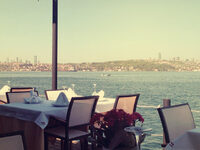 Balıkçı Abdullah is a restaurant that stands out from the rest with its fish, mezes, and extras. As the name implies, Abdullah is a balıkçı, or fisherman, who knows his fish and how to cook them. Day in, and day out, he’s at the ready, greeting customers. Even if he doesn’t go into the kitchen as often now, the chefs all receive training from him, meaning they cook up some really great fish. In contrast to many Turkish fish restaurants that dry fish out by overcooking it, Abdullah knows how to cook to just the right limit, meaning his fish and shrimp are juicy, just like they would be at an Italian or French restaurant. And to distract you as you wait for your meal, they also bring the best tarama in Istanbul, as well as pan-fried cornbread that they make on the premises. It’s so good I generally always ask for seconds. And quite apart from the meal, I could easily fill my belly just with this wonderful combination. In terms of meze, the normal tradition in Turkey is to choose your mezes from a tray that the waiter brings to your table, but at Balıkçı Abdullah, you may need to go to the kitchen to choose your mezes. But be careful, lest you eat so much meze that there’s no room for fish. One of the things that Abdullah’s does well is “lakerda” (bonito). But you won’t find any ready-made dish of lakerda at the restaurant, because it’s crucial to not cut off a wedge until the order is made. For me, the only problem is the fact that Abdullah’s is not right on the water; perhaps it’s psychological, but I’ve also thought it essential that a seaside place be right on the water. At Abdullah’s, however, there’s a walking path along the edge, meaning that even if you sit at the table closest to the edge, there are still three to five meters between you and the sea. I’m not a big fan of that, but there are more than enough other reasons that keep me coming back. For one, the restaurant has a big boat that can take you back and forth between the restaurant and İstinye on the European side of Istanbul, giving you 30 minutes of total travel time to soak in the Bosphorus. Without question, it’s a little boat trip that adds to your enjoyment when the weather is nice. The restaurant is open every day of the week, but it is closed at lunch. And although it seats 150 people, I recommend reservations ahead of time to guarantee a table. You certainly won’t regret it when you’re digging into Abdullah’s grilled shrimp, grilled seasonal fish, tarama and cornbread, and – in particular – lakerda.
Balıkçı Abdullah is a restaurant that stands out from the rest with its fish, mezes, and extras. As the name implies, Abdullah is a balıkçı, or fisherman, who knows his fish and how to cook them. Day in, and day out, he’s at the ready, greeting customers. Even if he doesn’t go into the kitchen as often now, the chefs all receive training from him, meaning they cook up some really great fish. In contrast to many Turkish fish restaurants that dry fish out by overcooking it, Abdullah knows how to cook to just the right limit, meaning his fish and shrimp are juicy, just like they would be at an Italian or French restaurant. And to distract you as you wait for your meal, they also bring the best tarama in Istanbul, as well as pan-fried cornbread that they make on the premises. It’s so good I generally always ask for seconds. And quite apart from the meal, I could easily fill my belly just with this wonderful combination. In terms of meze, the normal tradition in Turkey is to choose your mezes from a tray that the waiter brings to your table, but at Balıkçı Abdullah, you may need to go to the kitchen to choose your mezes. But be careful, lest you eat so much meze that there’s no room for fish. One of the things that Abdullah’s does well is “lakerda” (bonito). But you won’t find any ready-made dish of lakerda at the restaurant, because it’s crucial to not cut off a wedge until the order is made. For me, the only problem is the fact that Abdullah’s is not right on the water; perhaps it’s psychological, but I’ve also thought it essential that a seaside place be right on the water. At Abdullah’s, however, there’s a walking path along the edge, meaning that even if you sit at the table closest to the edge, there are still three to five meters between you and the sea. I’m not a big fan of that, but there are more than enough other reasons that keep me coming back. For one, the restaurant has a big boat that can take you back and forth between the restaurant and İstinye on the European side of Istanbul, giving you 30 minutes of total travel time to soak in the Bosphorus. Without question, it’s a little boat trip that adds to your enjoyment when the weather is nice. The restaurant is open every day of the week, but it is closed at lunch. And although it seats 150 people, I recommend reservations ahead of time to guarantee a table. You certainly won’t regret it when you’re digging into Abdullah’s grilled shrimp, grilled seasonal fish, tarama and cornbread, and – in particular – lakerda.
ITSUMI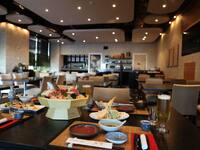 I have two favorite Japanese restaurants in Istanbul; I eat with gusto at both of them. One is Itsumi; the other is Zuma. Itsumi is an authentic Japanese restaurant, albeit with one difference: the availability of avocado. At Japanese-run Japanese restaurants in places like the United States, they use avocado, but it’s not something you’d ever see in Japan; in fact, if you ask for avocado, you’re unlikely to get a particularly positive response. (I speak from experience, having once made this faux pas in Japan.) But Itsumi isn’t in Japan, so it’s possible to find avocado sushi on the menu.Itsumi itself has a long back story. Twenty years ago, there was another Japanese restaurant in Istanbul where Itsumi’s present owner, Shunichi Horikoshi, was the sushi chef. Over the years, Horikoshi met his Turkish wife there, but one day, the restaurant changed hands, forcing the chef to look for new pastures. Opening a restaurant on his own was a financial undertaking beyond his means. Around that time, however, the Japanese company Mitsui opened a big office in Levent’s İşbank Towers that only employed Japanese workers. Devoid of food from home to eat, the employees went to Horikoshi with an offer he could hardly refuse: “We’ll foot the investment; you make the food.” That, in the end, is how Itsumi came to be. Today, Itsumi is open six days a week, serving lunch and dinner time. I, for one, am a fan of their miso soup and grilled fish – in addition to the sushi and sashimi, of course. Itsumi, in the end, is a place that doesn’t scrimp on quality in making food at a Japanese quality - all while offering it at a reasonable price.
I have two favorite Japanese restaurants in Istanbul; I eat with gusto at both of them. One is Itsumi; the other is Zuma. Itsumi is an authentic Japanese restaurant, albeit with one difference: the availability of avocado. At Japanese-run Japanese restaurants in places like the United States, they use avocado, but it’s not something you’d ever see in Japan; in fact, if you ask for avocado, you’re unlikely to get a particularly positive response. (I speak from experience, having once made this faux pas in Japan.) But Itsumi isn’t in Japan, so it’s possible to find avocado sushi on the menu.Itsumi itself has a long back story. Twenty years ago, there was another Japanese restaurant in Istanbul where Itsumi’s present owner, Shunichi Horikoshi, was the sushi chef. Over the years, Horikoshi met his Turkish wife there, but one day, the restaurant changed hands, forcing the chef to look for new pastures. Opening a restaurant on his own was a financial undertaking beyond his means. Around that time, however, the Japanese company Mitsui opened a big office in Levent’s İşbank Towers that only employed Japanese workers. Devoid of food from home to eat, the employees went to Horikoshi with an offer he could hardly refuse: “We’ll foot the investment; you make the food.” That, in the end, is how Itsumi came to be. Today, Itsumi is open six days a week, serving lunch and dinner time. I, for one, am a fan of their miso soup and grilled fish – in addition to the sushi and sashimi, of course. Itsumi, in the end, is a place that doesn’t scrimp on quality in making food at a Japanese quality - all while offering it at a reasonable price.
KIYI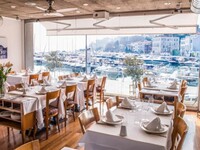 Kıyı is the oldest restaurant on this list. Fifty years after opening Kıyı, owner Yorgi Sabuncu is still in charge. And 50 years on, the flavor of some dishes hasn’t changed at all. Kıyı’s pickles, for instance, are out of this world. As far as I’m concerned, Kıyı is a fantastic fish restaurant with its pinto beans, fried liver, calamari plate with a taste all its own, lakerda made on site and fish cooked to perfection. I think I first went to Kıyı in 1968; back then, I was a high school student and Kıyı was a bit out of my price range. If I managed to scrape together my pennies, I would head to Kıyı once or twice a year. Years later, at the end of university, my friends and I celebrated our graduation at Kıyı, so the place has always had a special place in my heart. And just as he was doing half a century ago, Yorgi is still at the door to greet customers – really, it’s something that I haven’t witnessed at any other restaurant in Istanbul. Back in the day, a lot of restaurants like Kıyı used to take advantage of nice weather by setting up tables on the other side of the road right next to the water, giving you a front-row view of the sea. With trays in hand, waiters would exit the restaurant, cross the road and serve the tables. But in time, such delights stopped, and restaurants that operated as such began to close. Unlike others, however, Kıyı never closed, and it never compromised on its flavor or style. More than five decades on, I still go to Kıyı. The pickles, lakerda made on site, fish cooked to perfection, pinto beans, fried liver, and calamari leave the same delicious taste on the tongue as they did when I first savored them all those years ago. No, Kıyı hasn’t changed at all – apart from adding a second floor. I mean, 50 years ago, when no place had a valet, Kıyı had a valet on staff; a half-century on, the son of Kıyı’s old valet has supplanted his father to become the restaurant’s current valet. How’s that for continuity?
Kıyı is the oldest restaurant on this list. Fifty years after opening Kıyı, owner Yorgi Sabuncu is still in charge. And 50 years on, the flavor of some dishes hasn’t changed at all. Kıyı’s pickles, for instance, are out of this world. As far as I’m concerned, Kıyı is a fantastic fish restaurant with its pinto beans, fried liver, calamari plate with a taste all its own, lakerda made on site and fish cooked to perfection. I think I first went to Kıyı in 1968; back then, I was a high school student and Kıyı was a bit out of my price range. If I managed to scrape together my pennies, I would head to Kıyı once or twice a year. Years later, at the end of university, my friends and I celebrated our graduation at Kıyı, so the place has always had a special place in my heart. And just as he was doing half a century ago, Yorgi is still at the door to greet customers – really, it’s something that I haven’t witnessed at any other restaurant in Istanbul. Back in the day, a lot of restaurants like Kıyı used to take advantage of nice weather by setting up tables on the other side of the road right next to the water, giving you a front-row view of the sea. With trays in hand, waiters would exit the restaurant, cross the road and serve the tables. But in time, such delights stopped, and restaurants that operated as such began to close. Unlike others, however, Kıyı never closed, and it never compromised on its flavor or style. More than five decades on, I still go to Kıyı. The pickles, lakerda made on site, fish cooked to perfection, pinto beans, fried liver, and calamari leave the same delicious taste on the tongue as they did when I first savored them all those years ago. No, Kıyı hasn’t changed at all – apart from adding a second floor. I mean, 50 years ago, when no place had a valet, Kıyı had a valet on staff; a half-century on, the son of Kıyı’s old valet has supplanted his father to become the restaurant’s current valet. How’s that for continuity?
MIKLA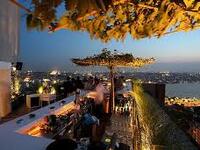 Mikla is a chic place on the roof of the Marmara Pera Hotel in Tepebaşı. Presiding over Mikla is owner/chef Mehmet Gürs, a man with a well-deserved international reputation. For me, there’s plenty of reasons to love this place. To start off with, the space itself and its location are superb. All the wait staff and bartenders are well-versed in their fields. In many restaurants, for instance, the waiters come and go, but not at Mikla; here, employee loyalty is high. And because they don’t like sourcing the ingredients from overseas, they make most of the culinary creations with ingredients that are available in Istanbul and the rest of Turkey. As it is, Mikla’s food is Turkish fusion. The restaurant’s view is also tremendous, as it overlooks the Golden Horn. With such a location, it’s beautiful by day or by night – if for different reasons. Of course, the beauty is indescribable in the summer, especially if there’s a full moon. If you’re lucky enough to snag one of the few tables on the lower terrace, there’s no doubt you’ll have your fill of both the full moon and the lights of Istanbul below you. On the top floor, there’s a roof bar, which, needless to say, provides the perfect panoramic spot for a pre-dinner drink. In Istanbul, only a few places have a wide-ranging wine menu, but Mikla is one of them, as it offers both domestic and international wines – and not at an astronomical price. Around 80 percent of Mikla’s clientele is international. And now they have a star from Michelin.
Mikla is a chic place on the roof of the Marmara Pera Hotel in Tepebaşı. Presiding over Mikla is owner/chef Mehmet Gürs, a man with a well-deserved international reputation. For me, there’s plenty of reasons to love this place. To start off with, the space itself and its location are superb. All the wait staff and bartenders are well-versed in their fields. In many restaurants, for instance, the waiters come and go, but not at Mikla; here, employee loyalty is high. And because they don’t like sourcing the ingredients from overseas, they make most of the culinary creations with ingredients that are available in Istanbul and the rest of Turkey. As it is, Mikla’s food is Turkish fusion. The restaurant’s view is also tremendous, as it overlooks the Golden Horn. With such a location, it’s beautiful by day or by night – if for different reasons. Of course, the beauty is indescribable in the summer, especially if there’s a full moon. If you’re lucky enough to snag one of the few tables on the lower terrace, there’s no doubt you’ll have your fill of both the full moon and the lights of Istanbul below you. On the top floor, there’s a roof bar, which, needless to say, provides the perfect panoramic spot for a pre-dinner drink. In Istanbul, only a few places have a wide-ranging wine menu, but Mikla is one of them, as it offers both domestic and international wines – and not at an astronomical price. Around 80 percent of Mikla’s clientele is international. And now they have a star from Michelin.
MÜRVER Mürver is a restaurant in Karaköy for which Mehmet Gürs has provided consultancy since its establishment. And thanks to its location, it’s another place that boasts a great view, this time of the Golden Horn and the historical peninsula. Mürver’s menu is heavy on meat and Turkish mezes. The restaurant cooks its meat in a wood-fire oven or over an open flame and, because it’s an open kitchen, diners have a chance to watch. Mürver’s kitchen serves up delicious main dishes, as well as small portions for the table as a whole. As for seafood, Mürver doesn’t serve a set of fish; they serve whatever’s fresh on the day you come. But whereas other places fry their fish on a grill or in a pan, Mürver cooks its fish in its wood-fire oven before bringing it to the table whole. After seeing the complete fish, you can either clean it and serve it yourself or ask one of the staff to do it for you. In terms of wine, Mürver is above the Turkish average, with a good balance between inexpensive and pricier offerings. My favorite dessert at Mürver is rice pudding (sütlaç) with ice cream. In terms of appearance, it’s a bit different than what we’re used to, but it’s so tasty you’ll be hogging it all to yourself. And like Mikla, Mürver is big on using fresh, local, and unfrozen ingredients for its fare. Ultimately, Mürver gives you a peak at different aspects of Mehmet Gürs’ philosophy and style at two different restaurants.
Mürver is a restaurant in Karaköy for which Mehmet Gürs has provided consultancy since its establishment. And thanks to its location, it’s another place that boasts a great view, this time of the Golden Horn and the historical peninsula. Mürver’s menu is heavy on meat and Turkish mezes. The restaurant cooks its meat in a wood-fire oven or over an open flame and, because it’s an open kitchen, diners have a chance to watch. Mürver’s kitchen serves up delicious main dishes, as well as small portions for the table as a whole. As for seafood, Mürver doesn’t serve a set of fish; they serve whatever’s fresh on the day you come. But whereas other places fry their fish on a grill or in a pan, Mürver cooks its fish in its wood-fire oven before bringing it to the table whole. After seeing the complete fish, you can either clean it and serve it yourself or ask one of the staff to do it for you. In terms of wine, Mürver is above the Turkish average, with a good balance between inexpensive and pricier offerings. My favorite dessert at Mürver is rice pudding (sütlaç) with ice cream. In terms of appearance, it’s a bit different than what we’re used to, but it’s so tasty you’ll be hogging it all to yourself. And like Mikla, Mürver is big on using fresh, local, and unfrozen ingredients for its fare. Ultimately, Mürver gives you a peak at different aspects of Mehmet Gürs’ philosophy and style at two different restaurants.
NEOLOKAL
 The old headquarters of Istanbul’s Ottoman Bank is known for its unique architecture. The place is currently home to a library and museum called Salt Galata, as well as a restaurant called Neolokal, run by chef/owner Maksut Askar. When Neolokal took over the restaurant from the previous owners, they changed everything but the kitchen, totally transforming the place for the better. The owner/the chef, and the menu all changed completely. The restaurant serves Turkish meals – with a unique take – and is open every day except Monday. This year they made it to the 120 best restaurants in the world as the second restaurant from Istanbul, adding to the long-timer Mikla’s presence. You can order meze and down some rakı, if you like or choose from the wine menu. On another note, there is a simple café in the same building that’s perfect for the peckish library and museum visitor, the famous Spanish restaurant Can Roca – one of the ”best of the best” - came to Turkey for a brilliant food event. Can Roca used Neolokal’s kitchen to cook and also made use of Neolokal’s chefs, providing an excellent opportunity for some knowledge transfer. I’ve learned that two Neolokal chefs later went to Can Roca in Girona for some training. Neolokal has a Michelin star and a Green Michelin star.
The old headquarters of Istanbul’s Ottoman Bank is known for its unique architecture. The place is currently home to a library and museum called Salt Galata, as well as a restaurant called Neolokal, run by chef/owner Maksut Askar. When Neolokal took over the restaurant from the previous owners, they changed everything but the kitchen, totally transforming the place for the better. The owner/the chef, and the menu all changed completely. The restaurant serves Turkish meals – with a unique take – and is open every day except Monday. This year they made it to the 120 best restaurants in the world as the second restaurant from Istanbul, adding to the long-timer Mikla’s presence. You can order meze and down some rakı, if you like or choose from the wine menu. On another note, there is a simple café in the same building that’s perfect for the peckish library and museum visitor, the famous Spanish restaurant Can Roca – one of the ”best of the best” - came to Turkey for a brilliant food event. Can Roca used Neolokal’s kitchen to cook and also made use of Neolokal’s chefs, providing an excellent opportunity for some knowledge transfer. I’ve learned that two Neolokal chefs later went to Can Roca in Girona for some training. Neolokal has a Michelin star and a Green Michelin star.
ROKA
 It was years ago when an Indian businessperson and his wife picked up and moved to London after having lived in the United States for many years. By this time, enjoying a partial retirement, the businessperson was dying to try Nobu, but he just couldn’t get reservations at its sole restaurant in London. Finally, he and his wife did manage to reserve, and both loved that they did. But, the businessperson thought, if a restaurant can do such a good job of fusing Peruvian and Japanese cuisine, what other possibilities were out there? Later, visiting Tokyo, he liked the food he had had at Tokyo’s Park Hyatt so much that he planned to bring that restaurant’s chef to London to open a place in the UK. Curiously, this Park Hyatt chef who happened to be such an expert in Japanese food was a German, Rainer Becker. In the end, the Indian businessperson and the German Chef Becker came to an agreement and opened Zuma on a back street at London’s Knightsbridge. In those times, I also found myself often going to London for work, and if I could score a table, I would go to Nobu. A friend, however, told me about this “fake Nobu” called Zuma, adding that it was a really enjoyable place. In time, I, too, started going to the “fake Nobu,” where there was always a table and much better prices. For me, it didn’t take long for Nobu to lose its luster, but for Londoners, it took another two or three years.
It was years ago when an Indian businessperson and his wife picked up and moved to London after having lived in the United States for many years. By this time, enjoying a partial retirement, the businessperson was dying to try Nobu, but he just couldn’t get reservations at its sole restaurant in London. Finally, he and his wife did manage to reserve, and both loved that they did. But, the businessperson thought, if a restaurant can do such a good job of fusing Peruvian and Japanese cuisine, what other possibilities were out there? Later, visiting Tokyo, he liked the food he had had at Tokyo’s Park Hyatt so much that he planned to bring that restaurant’s chef to London to open a place in the UK. Curiously, this Park Hyatt chef who happened to be such an expert in Japanese food was a German, Rainer Becker. In the end, the Indian businessperson and the German Chef Becker came to an agreement and opened Zuma on a back street at London’s Knightsbridge. In those times, I also found myself often going to London for work, and if I could score a table, I would go to Nobu. A friend, however, told me about this “fake Nobu” called Zuma, adding that it was a really enjoyable place. In time, I, too, started going to the “fake Nobu,” where there was always a table and much better prices. For me, it didn’t take long for Nobu to lose its luster, but for Londoners, it took another two or three years.
As for Zuma, it, like Nobu before, became a place where it was impossible to find a table and where it was out of the question to show up without a reservation. But in carving out a good place for itself in London, it did become a favorite haunt for a younger crowd. In time, different branches of Zuma started to appear around the world, including one in Istanbul. But Chef Becker didn’t warm to the idea of opening another Zuma in London: Instead, he liked the idea of opening a restaurant with a different name that would be smaller in size and menu but still serve up Japanese fusion. Ultimately, that is the origin story of Roka, a place that is half the size of Zuma, catering to an even younger clientele and boasting a large bar. At the time, Becker kept the prices down. Soon, Roka was such a raving success that other branches started to sprout up around London. And even if the menu was limited in comparison, it still offered food that one couldn’t find at Zuma. In short, the student soon surpassed the master.
Whenever I go to London, I try and go to a Roka; the one in Aldwych is my favorite. Even better, though, is the fact that Roka has gladdened my heart no end by opening a new branch in Istanbul at Galataport with a head Turkish woman chef who came home from one of the Rokas in England. To top it off, the Galataport Roka boasts the quality of London’s Roka locations to boot. Because of the pandemic, after all, I haven’t had a chance to go to a Roka in London for a while, yet the flavors the restaurant serves up are still on the tip of my tongue. The Roka at Galataport offers the same taste and, needless to say, the standard of the fare is extraordinarily high. So too, is the service quality and the location: From your table on the terrace, you can take in one of Istanbul’s bridges over the Bosphorus and the historical peninsula at the same time. What’s more, it’s situated favorably enough that even the cruise ships that berth at Galataport don’t block all of the stunning view. But even for those sitting inside, the décor is tasteful and extremely comfortable. More to the point, I reckon watching the cooks at work in the restaurant’s open-kitchen concept is a delight.
SEA SALT
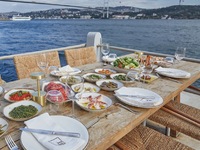 The Sea Salt Restaurant is a new seafood restaurant that has opened inside the Kabataş Boys’ School. For the most part, the restaurant’s sea fare comes from İzmir. The chefs, meanwhile, cook their Aegean fish, Biga shrimp and small Aegean kalamari to perfection. They also offer some mezes that you typically only find in Aegean restaurants. The restaurant is located right on the water. If you’re lucky enough to grab a table right on the water, you’ll be over the moon. Sea Salt also serves lunch.
The Sea Salt Restaurant is a new seafood restaurant that has opened inside the Kabataş Boys’ School. For the most part, the restaurant’s sea fare comes from İzmir. The chefs, meanwhile, cook their Aegean fish, Biga shrimp and small Aegean kalamari to perfection. They also offer some mezes that you typically only find in Aegean restaurants. The restaurant is located right on the water. If you’re lucky enough to grab a table right on the water, you’ll be over the moon. Sea Salt also serves lunch.
ŞANS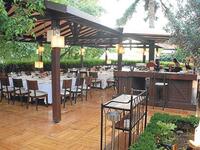 Şans, best-known as a place for work-related meals, is a restaurant that largely serves Turkish and Mediterranean cuisine. Because it’s located in an area with a lot of business people , it’s fairly crowded come lunch, but it’s much quieter come evening. I eat several business meals a week there. Niso Adato, Şans’ proprietor of many years, is also a friend of mine. Under the direction of Sait, the same team has been waiting on tables . I’m especially a fan of Şans’ olive-oil dishes which, in addition to being delicious, are also healthy. Şans also has Istanbul’s best chocolate soufflé. If you can find a table, I recommend it for your business lunch, but if you want to eat a quiet dinner – which could be a business dinner as well, of course – be sure to put Şans on your list. Before the pandemic, one of Istanbul’s best restaurants opened by a foreign chef was Rudolf, a place operated by a Dutchman of the same name in Karaköy. Time Out’s readers, in fact, christened Rudolf as the city’s best restaurant. Rudolf, unfortunately, only lasted two years, but during that time, I made sure to go there as often as possible. Amid the pandemic, Rudolf van Nunen relocated to Gökçeada. But as he and his wife made plans to open a restaurant there, Şans in Istanbul managed to convince him to take over its kitchen. Now, in addition to Şans’ classic fish soup, lamb neck and beef ribs, you can also dig into Istanbul’s best sea bass, local asparagus and souffle with Belgian chocolate – all thanks to Rudolf van Nunen. If you have trouble finding a table for lunch, try making a reservation for the evening, when it’s easier.
Şans, best-known as a place for work-related meals, is a restaurant that largely serves Turkish and Mediterranean cuisine. Because it’s located in an area with a lot of business people , it’s fairly crowded come lunch, but it’s much quieter come evening. I eat several business meals a week there. Niso Adato, Şans’ proprietor of many years, is also a friend of mine. Under the direction of Sait, the same team has been waiting on tables . I’m especially a fan of Şans’ olive-oil dishes which, in addition to being delicious, are also healthy. Şans also has Istanbul’s best chocolate soufflé. If you can find a table, I recommend it for your business lunch, but if you want to eat a quiet dinner – which could be a business dinner as well, of course – be sure to put Şans on your list. Before the pandemic, one of Istanbul’s best restaurants opened by a foreign chef was Rudolf, a place operated by a Dutchman of the same name in Karaköy. Time Out’s readers, in fact, christened Rudolf as the city’s best restaurant. Rudolf, unfortunately, only lasted two years, but during that time, I made sure to go there as often as possible. Amid the pandemic, Rudolf van Nunen relocated to Gökçeada. But as he and his wife made plans to open a restaurant there, Şans in Istanbul managed to convince him to take over its kitchen. Now, in addition to Şans’ classic fish soup, lamb neck and beef ribs, you can also dig into Istanbul’s best sea bass, local asparagus and souffle with Belgian chocolate – all thanks to Rudolf van Nunen. If you have trouble finding a table for lunch, try making a reservation for the evening, when it’s easier.
TURK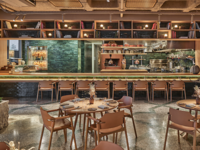 Turk, a place that Fatih Tutak – the owner of a well-known restaurant in Bangkok – has opened in Bomonti, is a restaurant that does Turkish fusion. Turk is a place that’s poised to enter the list of the world’s best restaurants. They have recently received two stars from Michelin. Turk, a place with high ceilings, comfortable chairs and an open kitchen, is a chic and spacious restaurant that gets the details right. The only downside is the poor acoustics; hopefully, it’s something they can fix. Still, Turk has delectable warm bread, scrumptious shrimp, grouper that is fresh as can be, vegetable-filled mantı, unique desserts and a wine list that features well-chosen domestic wines. The restaurant only seats 60 people. Given that, I do hope that Turk doesn’t emulate other good, newly opened restaurants in Istanbul by getting carried away with its success by adding more tables or jumping on the bandwagon of organizing double sittings at dinner. Turk is open Monday to Saturday in the evenings, although it’s easier to find a table on weekdays.
Turk, a place that Fatih Tutak – the owner of a well-known restaurant in Bangkok – has opened in Bomonti, is a restaurant that does Turkish fusion. Turk is a place that’s poised to enter the list of the world’s best restaurants. They have recently received two stars from Michelin. Turk, a place with high ceilings, comfortable chairs and an open kitchen, is a chic and spacious restaurant that gets the details right. The only downside is the poor acoustics; hopefully, it’s something they can fix. Still, Turk has delectable warm bread, scrumptious shrimp, grouper that is fresh as can be, vegetable-filled mantı, unique desserts and a wine list that features well-chosen domestic wines. The restaurant only seats 60 people. Given that, I do hope that Turk doesn’t emulate other good, newly opened restaurants in Istanbul by getting carried away with its success by adding more tables or jumping on the bandwagon of organizing double sittings at dinner. Turk is open Monday to Saturday in the evenings, although it’s easier to find a table on weekdays.
İSKELE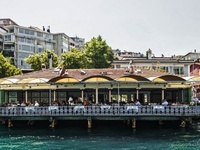 Located on a historical pier near Rumeli Hisari, İskele protrudes into the sea, offering you a vista of the Bosphorus on three sides. İskele (whose very name means pier) has good fish and meze. Regrettably, they don’t have an outdoor dining area; come summer, they open the windows, but that’s not the same as dining al fresco. Still, the view of Anadolu Hisari across the water on the Asian side is beautiful. If they do have swordfish ask them to cook and serve it “Cem Boyner” style. And have your selection of mezes waiting for it. Moreover, the boats going to some of the top fish restaurants on the Asian side, Lacivert and Uskumru, also depart from the vicinity, meaning that if you’re ever in the area, you have three different fish restaurant options. In many restaurants around the world, you can order the same fish on the menu almost all year round. Most fish, however, in Istanbul has a season. For example, bonito is good in September; bluefish is best in October, large bluefish “kofana” is in November, and turbot is in season come December and February. Why would one eat sea bass or salmon all year when one can eat different fish around the year?
Located on a historical pier near Rumeli Hisari, İskele protrudes into the sea, offering you a vista of the Bosphorus on three sides. İskele (whose very name means pier) has good fish and meze. Regrettably, they don’t have an outdoor dining area; come summer, they open the windows, but that’s not the same as dining al fresco. Still, the view of Anadolu Hisari across the water on the Asian side is beautiful. If they do have swordfish ask them to cook and serve it “Cem Boyner” style. And have your selection of mezes waiting for it. Moreover, the boats going to some of the top fish restaurants on the Asian side, Lacivert and Uskumru, also depart from the vicinity, meaning that if you’re ever in the area, you have three different fish restaurant options. In many restaurants around the world, you can order the same fish on the menu almost all year round. Most fish, however, in Istanbul has a season. For example, bonito is good in September; bluefish is best in October, large bluefish “kofana” is in November, and turbot is in season come December and February. Why would one eat sea bass or salmon all year when one can eat different fish around the year?
FINCAN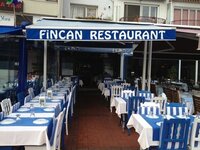 Besides eating fish by the Bosphorus, you can also dig into some seafood on one of the Prince Islands. All five islands are home to hundreds of fish restaurants along their long shorelines. The islands are very busy on the weekends when eateries tend to focus their efforts. For this reason, the places have become pretty touristy, meaning waiters will often be pretty insistent that you sit down to eat if you happen to be walking past the front. Most of the island restaurants bring fish from markets in Istanbul rather than procuring them from fishermen on the island. Still, there’s a really nice, small, family restaurant on Burgaz Island that I like, Fincan, which is run by Canan and Rasim. Canan is incredibly talented in the kitchen, while her husband, Rasim, is skilled in service. You can eat all day in Fincan, from breakfast to dinner. Canan prepares around 40 types of “meze” changing depending on the season, but they serve up tasty international starters as well. Moreover, they cook the fish really well – although I usually forego the fish at Fincan just so I can sample all their meze. Note, though, that their wine list is limited. Even if you go to another island, I would recommend you stop by Burgaz for some lunch or dinner at Fincan. There’s also an ice cream parlor nearby, which, I think, has the best ice cream in all of Istanbul. Go and get an ice cream after eating well at Fincan.
Besides eating fish by the Bosphorus, you can also dig into some seafood on one of the Prince Islands. All five islands are home to hundreds of fish restaurants along their long shorelines. The islands are very busy on the weekends when eateries tend to focus their efforts. For this reason, the places have become pretty touristy, meaning waiters will often be pretty insistent that you sit down to eat if you happen to be walking past the front. Most of the island restaurants bring fish from markets in Istanbul rather than procuring them from fishermen on the island. Still, there’s a really nice, small, family restaurant on Burgaz Island that I like, Fincan, which is run by Canan and Rasim. Canan is incredibly talented in the kitchen, while her husband, Rasim, is skilled in service. You can eat all day in Fincan, from breakfast to dinner. Canan prepares around 40 types of “meze” changing depending on the season, but they serve up tasty international starters as well. Moreover, they cook the fish really well – although I usually forego the fish at Fincan just so I can sample all their meze. Note, though, that their wine list is limited. Even if you go to another island, I would recommend you stop by Burgaz for some lunch or dinner at Fincan. There’s also an ice cream parlor nearby, which, I think, has the best ice cream in all of Istanbul. Go and get an ice cream after eating well at Fincan.
